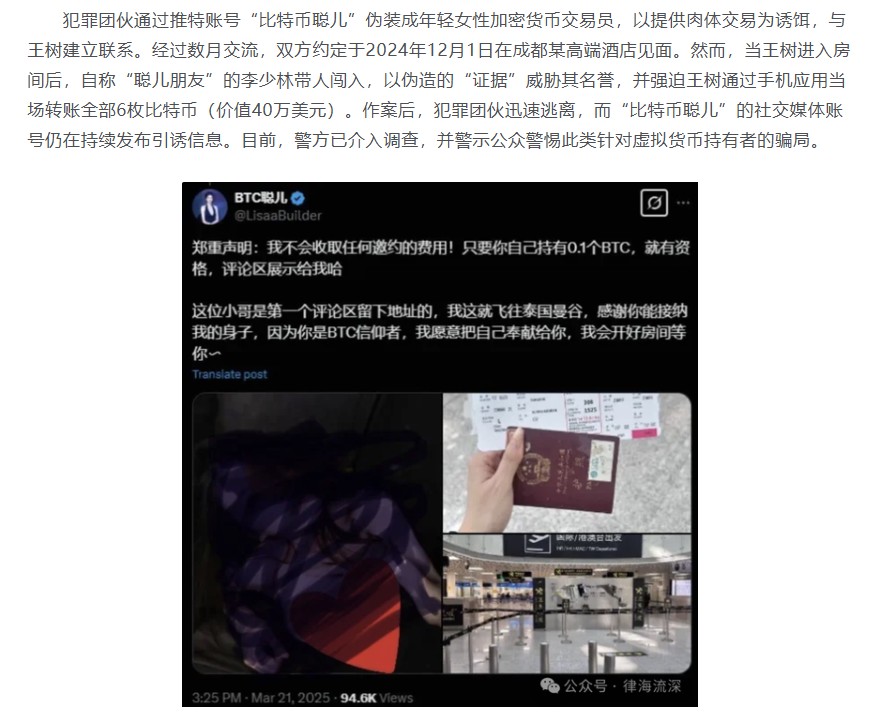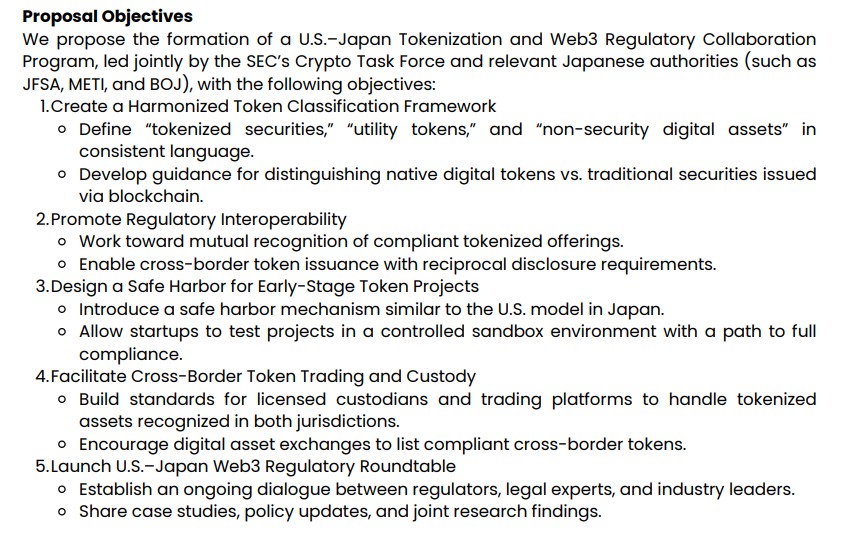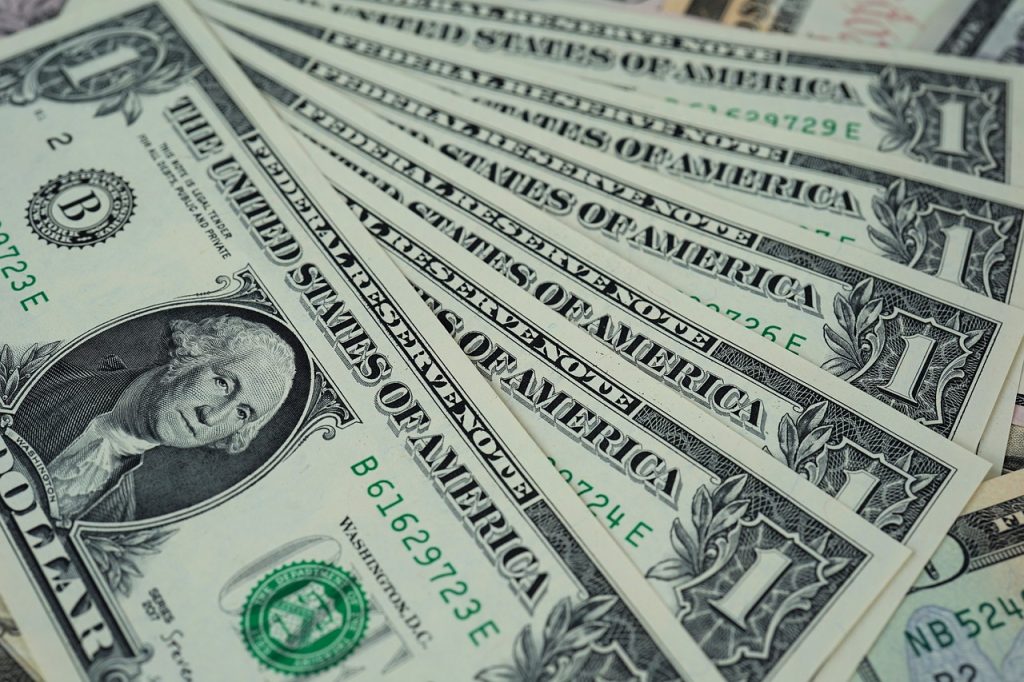|
|
Spend the night with a BTC holder stunt turns scandalous after extortion link
A viral crypto influencer’s “spend the night with BTC holders” stunt has taken a dark turn after Chinese media linked her profile to a real-life extortion case.
On March 25, Sina Finance reported that in 2024, a software engineer in Chengdu was ambushed and robbed of 6 BTC by a criminal gang posing as a female crypto trader named “Bitcoin Cong’er.”
The group had allegedly lured the victim through an X profile that promised sexual favors after months of online communications. Once the victim agreed to meet at a high-end hotel in Chengdu, the perpetrators reportedly used fabricated evidence to threaten the victim’s reputation, ultimately extorting a 6 BTC transfer.
Police are investigating the incident and have issued public warnings about similar scams targeting crypto users, according to Sina Finance.
The report quickly raised eyebrows because just days earlier, a Mandarin-speaking social media user going by BTCconger, formerly known as LisaaBuilder, had gone viral for a strikingly similar stunt.

On March 20, the account posted a message on X, urging users to drop their Bitcoin addresses in the replies. She claimed she would “spend the night” with anyone holding at least 0.1 BTC — no fees, no strings attached. She even described the note as a “suicide letter,” stating that she no longer belonged to herself, but to all Bitcoin holders and believers. The tweet collected over 2 million views.
BTCconger doubled down, posting photos and videos of herself apparently meeting up with her followers, and flying to Bangkok. In one tweet, she posted a selfie in a hotel mirror with a condom visible on the table, claiming that someone didn’t show up at the promised location and time. In another video, she is seen sitting on a bed with three men, reading and reciting the Bitcoin white paper, some sections in unison.
Reactions were mixed. Some X users played along and posted wallet addresses. Others called it an entertaining and clever method to grab attention. Some urged her to reconsider for safety reasons, while several female users criticized the post for perpetuating damaging stereotypes about women in crypto.
After the Sina Finance article surfaced, her campaign came under fresh scrutiny as the report included a screenshot of one of her tweets.

In a live-streamed interview on March 26 with local content creator Robert Lee, BTCconger denied any involvement in the Chengdu case. She stated she is currently in the mainland in Shenzhen and argued that if she were connected to a crime, she’d already be under arrest. She also pointed out that the extortion case occurred earlier in 2024, while her account only rebranded from LisaaBuilder to BTCconger “a few days ago.” She said she has gathered notarized evidence and plans to file a formal report to defend herself.
BTS parent firm HYBE pulls the plug on blockchain subsidiary
HYBE, the K-pop powerhouse behind BTS, is reportedly scaling back its blockchain ambitions after a short and unprofitable run. As reported by News1 on March 27, HYBE plans to absorb its blockchain subsidiary Binary Korea, effectively pulling back from direct involvement in Web3 ventures.
Binary Korea was launched in 2022 as part of HYBE’s broader push into the digital creator economy. The move followed HYBE’s 2021 partnership with Upbit operator Dunamu, which included plans to issue BTS non-fungible tokens (NFTs). Those plans were ultimately shelved following widespread backlash.
BTS-related merchandise already stood as a juggernaut without blockchain gimmicks. From the sold-out McDonald’s meal in 2021 to the wildly popular Map of the Soul tour merch — even after the tour was canceled due to the pandemic — BTS products have consistently generated millions in revenue. Spin-off lines like TinyTAN, animated characters based on the group, have become standalone brands, appearing in everything from stationery and tech accessories to home appliances.

However, the NFT announcement sparked a fierce backlash from members of the BTS fandom known as ARMY, who raised concerns about environmental impact and over-commercialization.
HYBE never released BTS NFTs, though it moved forward with other blockchain initiatives, including a joint venture with Dunamu in the US called Levvels. That venture launched Momentica, an NFT platform featuring other HYBE artists — but notably excluding BTS. Without the group’s involvement, the platform failed to gain meaningful traction.
Binary Korea posted just 468,000 Korean won (about $350) in revenue in 2023, with a net loss of 4.28 billion Korean won (about $3.2 million), according to News1. Another HYBE platform, THEUS, also failed to deliver results, despite a recent Coinbase partnership aimed at integrating blockchain-based fan engagement tools.
A HYBE spokesperson cited by the outlet downplayed the retreat and noted that the decision has not yet been finalized.
Japan proposes US collab to build global token standards
A new proposal from Japan is calling for the US and Japan to join forces on regulating tokenized assets and shaping the global Web3 economy. The five-part plan, submitted to US Securities and Exchange Commission Commissioner Hester Peirce, outlines a path toward harmonized digital asset frameworks, mutual recognition of compliant offerings and the creation of safe testing environments for blockchain startups.
The proposal, authored by Hinza Asif, president of the Asia Web3 Alliance Japan, recommends a joint US-Japan regulatory collaboration program with five core objectives.

The letter, dated March 25 and addressed to Peirce in her capacity as chair of the SEC’s Crypto Task Force, highlights the growing difficulties faced by Japanese Web3 startups. Asif wrote that despite strong interest in blockchain and tokenization, from real estate to loyalty points, many projects are paralyzed by legal uncertainty and inconsistent tax and securities treatment.
Currently, Japan lacks a clear framework for token offerings, leaving startups at risk of regulatory overreach. Meanwhile, the US has made progress through safe harbor discussions and efforts to define digital asset categories. Asif said this approach could serve as a model for international collaboration.
Circle expands USDC footprint in Asia
Circle’s USDC stablecoin is gaining momentum in Asia following two major developments in Japan and the Philippines.
The company announced the March 26 launch of USDC in Japan on the SBI VC Trade crypto exchange. The listing follows regulatory approval granted on March 4, when SBI VC Trade became the first exchange in Japan authorized by the Financial Services Agency to list USDC under the country’s stablecoin regulatory framework.
In the Philippines, Circle has partnered with GCash, the nation’s most widely used digital wallet, to bring USDC support to its nearly 100 million users.

As GCash expands its financial services, discussions around a possible initial public offering (IPO) continue to generate buzz. Globe Telecom CEO Ernest Cu, whose firm has a stake in GCash through parent company Mynt, confirmed that an IPO is still being considered in a February press conference. However, he said the company is aiming to float a smaller share than the 20 percent public minimum currently required by the Philippine Stock Exchange and the local SEC.
Reports suggest GCash could target a valuation of at least $8 billion, though Cu noted there is no set timeline for a public listing. The SEC has voiced support for a GCash IPO and is open to reviewing a formal request for exemption from the float requirement, potentially easing the path for the fintech giant to go public.
While USDC continues to expand in compliance-driven markets, its top rival, Tether’s USDT, is facing pressure in the European Union, where several exchanges have delisted the token due to the new Markets in Crypto-Assets (MiCA) regulation. Tether, however, is making strides of its own and said it is in talks with a Big Four accounting firm to conduct a long-awaited financial audit.


Yohan Yun
‘Terra hit us incredibly hard’: Sunny Aggarwal of Osmosis Labs
“When I first laid my eyes on the Cosmos whitepaper in 2017, everything just clicked.”
Read moreBitcoin in jeopardy, Ether briefly breaks records, Biden takes action: Hodler’s Digest, Jan. 17–23
The best (and worst) quotes, adoption and regulation highlights, leading coins, predictions and much more — one week on Cointelegraph in one link!
Read moreGood luck suing crypto exchanges, market makers over the flash crash


